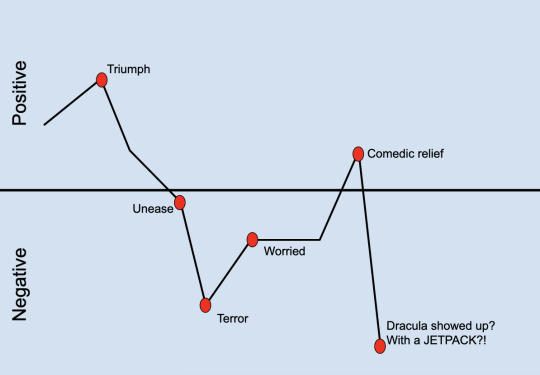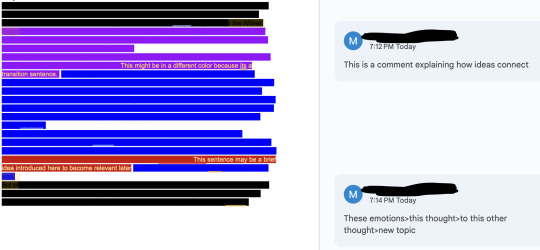#mfr is going slowly but surely. As it has for months..
Text
Writing advice
Writing Mandatory Family Reunion has gotten to the point of emotionally convoluted that I'm making scene roller coaster charts and color coding parts of the text by topic. Which, I highly recommend these writing tools. A roller coaster map is something I picked up from theater, and is useful for structuring emotions. A quick example below:

Its where you plot a timeline oscillating between positive and negative emotions, and how quickly they're switched between. It helps to know where you want the emotional peak/pit for a scene/chapter/story, so you can arrange plot beats accordingly. Many stories try to have escalating conflict, so you can use this method to gauge the intensity of reactions to crisis in order to achieve this. The problem I had with my chapter was whiplash between emotions, so by charting it out I could see where transitions needed to smooth jarring flips between emotional extremes. Flooring the gas pedal can also be bad, so the roller coaster method lets you see how quickly you switch between major emotions, and where breathing room may be helpful.
There is a problem with the axis being positive to negative. While capturing the intensity goes alright, it's hard to distinguish different types of emotions. Anger, fear, and sorrow are all negative, but also feel very different to a reader. So at peaks/plummets I made little notes about the majority emotion there. I found the roller coaster method made it easier to understand how my character's would react based off their accumulating emotional/mental state, and you can multiple to track the journeys of multiple characters.
As for the color coding method, I use it for structuring ideas. I took sections of the text in a scene and colored them based on the topic. Using comment options can also be super useful. A following example, redacted so I don't spoil my readers lol:

This helped with tracking the development of an idea in a scene where many interweaving subjects were being covered. I first focused on just how that idea changed over the course of the scene, and the next and next. Then, I looked at the transitions between each colored block, mostly the last/first two sentences between the concepts. That way I could see if there was a clear flow of logic between one topic to the next. Then, I started rearranging the parts into a way that structured a more solid scene. The scene felt a little bit like a puzzle, trying to get transitions to line up, switching around colored paragraphs into an order that made sense both for the individual argument angle as well as how it contributed to the other topics. I personally was using this for an internal monologue heavy scene, but I imagine it could also work pretty well for conversations.
Anyway, these are just some tools I use when I dislike a scene but can't figure out why. Visualizing the story can really help when trying to structure the ideas and emotions. Happy writing!
#sidenote: whoever said writing an unreliable narrator is easier needs to be shot#im working myself to death trying to figure out this guy's internal monologue.#writer woes#writing advice#writeblr#writing#fic writing#story telling#writing tips#mfr is going slowly but surely. As it has for months..#ok. I finished the most recent chapter like 2 months ago and hated it for reasons I couldn't figure out so I never published#but the rollercoaster chart helped me figure it out#something to nom on
11 notes
·
View notes